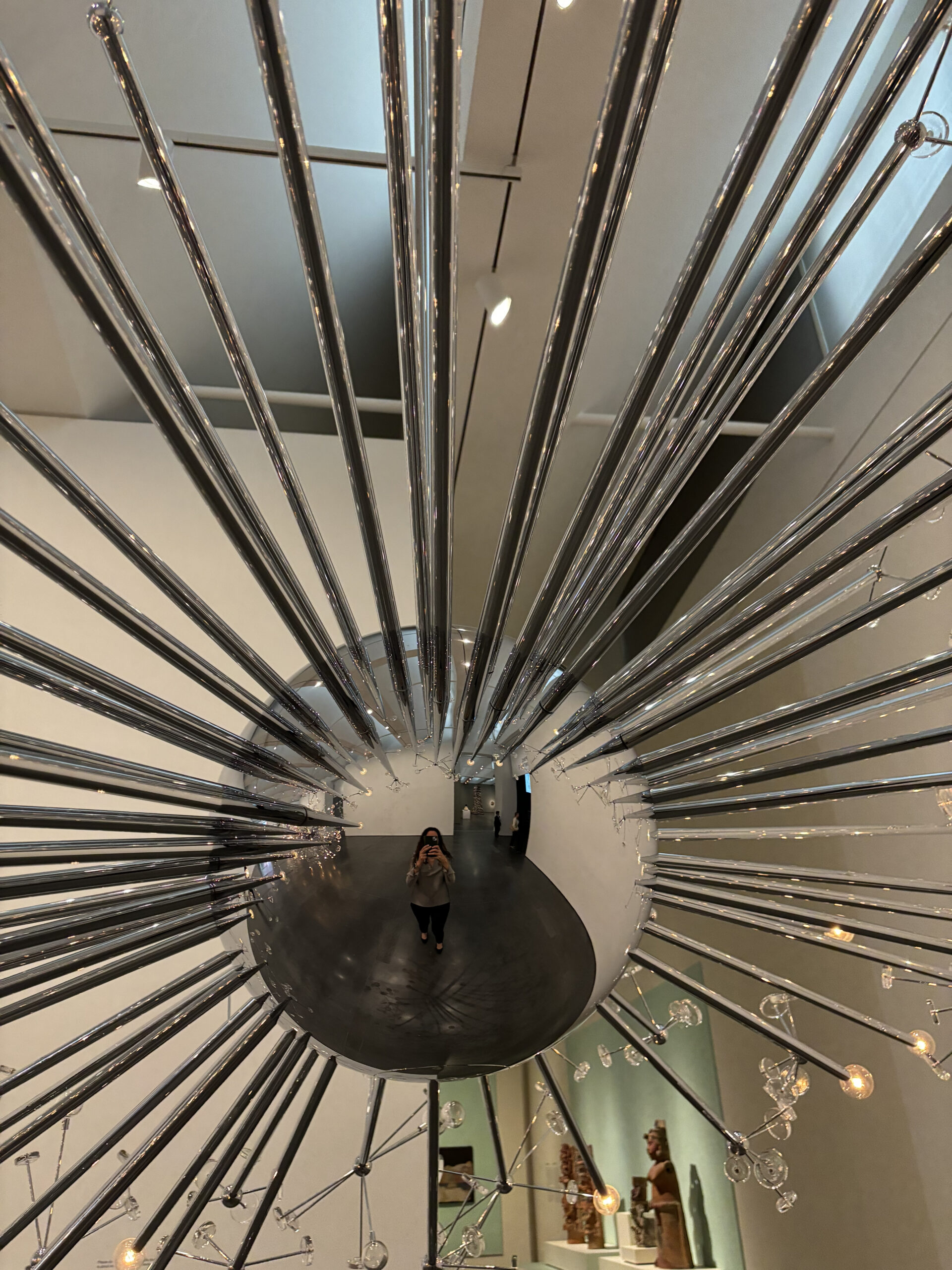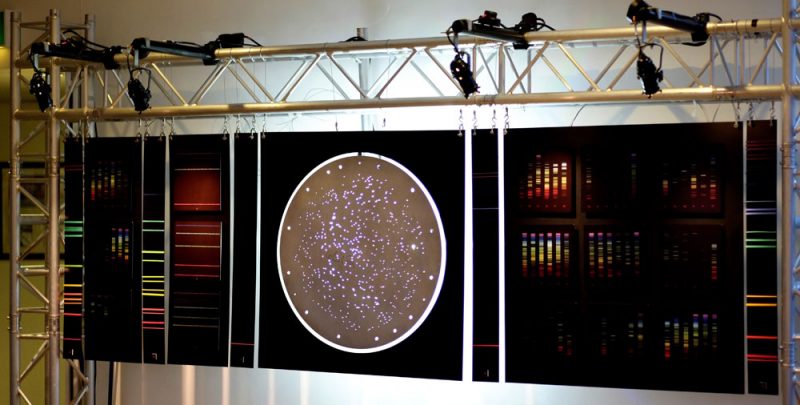
Science and Art have had an everlasting dialogue of inspiring one another. The Sloan Digital Sky Survey continues this tradition in its scientific results, its hardware, and its conception. SDSS presents interesting challenges and opportunities to artists. Firstly, one of its primary missions is spectroscopic observations. Spectroscopy is both omnipresent in the rainbows, sounds, and temperature sensations we experience from youth, and simultaneously, notoriously difficult to conceptualize and visualize from its quantum mechanical roots. It therefore has an element that is far more abstract than the typical sweeping celestial vistas that adorn both posters and press releases. Secondly, SDSS leaves physical artifacts behind in the form of metal plates and now robots for its spectroscopic observations.
This page details the diverse and ingenious ways artists around the world have interpreted SDSS science, data and plates to produce work that is both visually stunning and thought-provoking.
SDSS worked closely with curator Stephen Little at the LA County Museum of Art (LACMA), on a massive project undertaken as part of the Getty Museum’s PST Art: Art and Science Collide. The exhibition, “Mapping the Infinite: Cosmologies Across Cultures”, is a journey through humanity’s relationship with the cosmos, showcasing nearly 120 rare artifacts from 12 millennia and 15 civilizations—ranging from Stone Age monuments to modern scientific tools .A highlight is the inclusion of contemporary cosmological science within this historical tapestry. The show features an immersive, floor-to-ceiling projection of a galaxy survey from the Sloan Digital Sky Survey, guided by SDSS-V Director Juna Kollmeier.
This exhibition spanned millennia —from symbolic star maps and sacred architecture to modern galaxy surveys—reveals a shared impulse: mapping the cosmos. In this exhibition, SDSS acts as a living thread, connecting ancient cosmologies to contemporary cosmic cartography, and invites viewers to consider our ongoing quest to understand the universe and our place within it.

Tim Fitzpatrick worked with SDSS as its “Artist in Residence” from 2015-2020. Tim’s work incorporates both used SDSS plates and spectroscopic data from SDSS and other sources. In “the event of always falling back down again” uses different materials, finishes and colors to display sections of the solar spectrum as different visual landscapes.

Prior to joining SDSS, Tim, working with SDSS astronomer Anne-Marie Weijmans from the University of St Andrews, created Shine, an exploration of the information encoded in light. This led to representations of spectra on paper, steel, errupting up a mountainside or on the roof of an former jailhouse in New Mexico.
Kathryn Cellerini Moore created, with the help of SDSS astronomer Sarah Tuttle, created Galactic Ping Pong at Chemeketa Community College in Salem, Oregon. This uses SDSS plates, salt sculptures and light projections along with sound incorporating data from NASA’s Chandra X-ray telescope to build a stunning immersive space.

In 2016, Chinese artist Jian Yang organised an exhibit in Beijing entitled “The Beginning of Infinity” which included a piece incorporating an SDSS plate. In one Chinese folk tale, the sky is an elephant. If you can find the elephant’s leg you can climb up an touch the stars. In the piece the SDSS plate is used as the foot of the elephant, the first point on a journey to grasp the heavens.

The Center is Everywhere
At the Institute of Contemporary Art in Boston, artist Josiah McElheny in collaboration with SDSS astronomer David Weinberg created a breathtaking glass-and-lamp sculpture titled The Center is Everywhere, based on SDSS data (also described here and in this NYTimes Article). It translates the three-dimensional distribution of galaxies—captured through SDSS plugplates—into hundreds of suspended glass crystals and light points. This artwork reflects philosophical ideas about the infinite and self‑similarity in the cosmos” (also described here and in this NYTimes Article). This piece takes its title from the idea that in an infinite universe there is no unique center, This artwork reflects philosophical ideas about the infinite and self‑similarity in the cosmos.
London-based conceptual artist Xavier Poultney, working with astronomers from SDSS institutions including the University of Portsmouth, included SDSS material in an exhibit entitled “Transient Objects” which looked at how ideas and items change and become layered into the strata of human societies over time.



Sarah Ruether (pictured on the Left above), a Seattle-based artist, used an SDSS plate to produce a work that echos the form of the SDSS telescope at the Apache Point Observatory.
Nashville-based Adrienne Outlaw also crafts sculptures from SDSS spectroscopic plug plates—those circular aluminum disks used during observations. Her artistic interpretations were featured at Vanderbilt University during the Inclusive Astronomy conference. These works highlight the beauty of the physical artifacts behind SDSS’s science.
SDSS Data‑Driven Digital Art
Groups like ISM Creative have been building interactive audiovisual platforms using SDSS 3D maps and spectra. These installations leverage SDSS datasets to create immersive art, translating vast astronomical structures into engaging digital experiences
Why It Matters
Across these projects, SDSS serves as both medium and muse—its spectroscopic plates, galaxy maps, and data visualizations become bridges between scientific inquiry and visual storytelling. These artworks amplify public engagement, showcasing how serious scientific tools can yield aesthetic and conceptual inspiration. Whether rendered in glass, light, steel, or pixels, SDSS‑based art challenges viewers to rethink data—not merely as numbers, but as portals to wonder.
